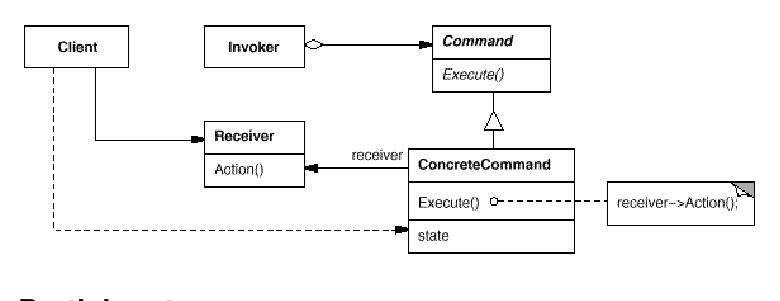Command
| Line 1: | Line 1: | ||
| + | [[Category:Design Patterns]] | ||
In the Command pattern objects are used to represent actions. An action and its parameters are encapsulated by a command object. | In the Command pattern objects are used to represent actions. An action and its parameters are encapsulated by a command object. | ||
Revision as of 03:28, 16 July 2009
In the Command pattern objects are used to represent actions. An action and its parameters are encapsulated by a command object.
Contents |
Usage
Sometimes you need to issue a request to an object without even knowing anything about the requested operation or the receiving object itself, then it is useful to apply the Command pattern. A situation where to use the Command pattern would be for example the implementation of a menu in a GUI. Every single menu item has its own corresponding concrete command object, which implement a command interface. When the user clicks on a menu item the menu item calls the execute() method of its command object. The execute() method carries out an operation. The concrete commands store the receiver and call up one or more operations on the receiver. Good examples for menu items would be the opening and closing of documents or also pasting some text. Another example would be a PrintJob whereas the PrintCommand objects execute set the properties (the document to be printed, the number of copies, and so on), and finally call a method to send the job to the printer. (undo operations, GUI buttons and menut items, networking, parallel processing, ...)
- a command object is a convenient place to collect code and data related to a specific action
- treating commands as objects supports undo-able operations, provided that the command objects are stored (eg in a stack)
- the construction of a command and the actual execution of that command happen at different times
UML Diagram
Participants
Command
- declares an interface for executing an operation.
ConcreteCommand (PasteCommand, OpenCommand)
- defines a binding between a Receiver object and an action.
- implements Execute by invoking the corresponding operation(s) on Receiver.
Client (Application)
- creates a ConcreteCommand object and sets its receiver.
Invoker (MenuItem)
- asks the command to carry out the request.
Receiver (Document, Application)
- knows how to perform the operations associated with carrying out a request. Any class may serve as a Receiver.
